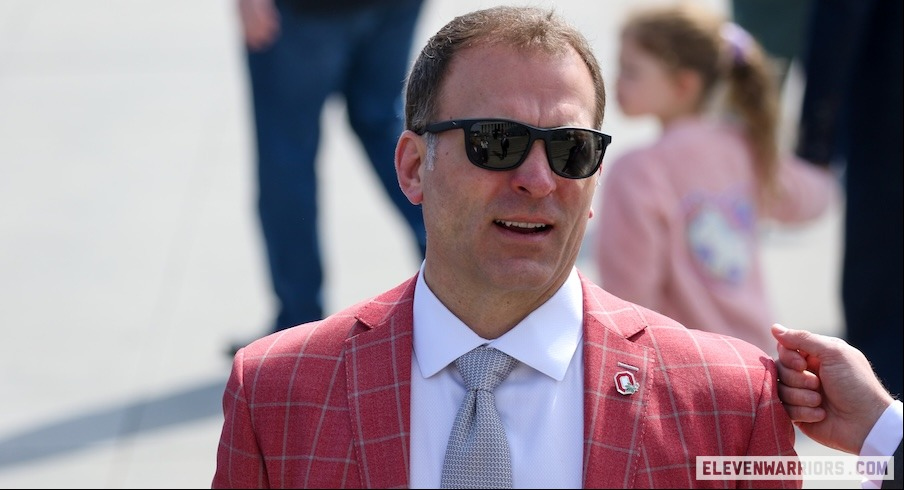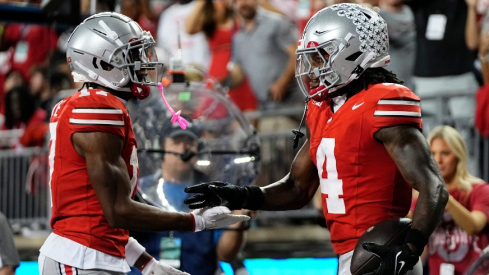A new era of college sports has officially begun.
For the first time ever, NCAA schools are allowed to directly share revenue with their athletes as a result of the House v. NCAA settlement that was finalized last month. While college athletes have been able to make money off of their names, images and likenesses since 2021, the 2025-26 season will be the first time that athletes receive payments from their schools that aren’t directly tied to academics.
Ohio State athletic director Ross Bjork announced last month that OSU will share revenue with athletes from four of its 36 varsity sports – football, men’s basketball, women’s basketball and women’s volleyball – in the first year of the new model. Football, men’s basketball and women’s basketball are the three Ohio State sports that generate the most revenue – in that order – while volleyball generates the second-most revenue among Ohio State’s women’s sports teams.
With the new model now officially in effect as of today, we’ve rounded up what you need to know about how revenue sharing will work, what other changes are coming to college sports as part of the new model and how Bjork and Ohio State are approaching the changes.
Buckeyes will share $18 million with athletes in 2025-26
The salary cap – so to speak – for the first year of revenue sharing is set at $20.5 million, an amount roughly equal to 22% of the average total revenue generated by Power 4 athletic departments. That cap will be increased by 4% for each of the next two years, then will be re-evaluated before the 2028-29 season.
Schools that have chosen to add extra scholarships now that scholarship limits have been eliminated, however, are required to count those scholarship funds against their cap up to $2.5 million. Since Ohio State is adding 91 new scholarships across its 36 sports, it is allowed to share $18 million directly with its athletes.
Bjork declined to say during his press conference last month how much revenue would be shared with each sport, saying “numbers create narratives.” That said, it’s expected that a sizable majority of that $18 million will be paid to football players, reflecting the fact that football is by far Ohio State’s top revenue-generating sport.
In addition to setting up revenue sharing for current athletes, the House v. NCAA settlement also created a backpay fund that will be used to pay athletes who played for Division I sports teams from 2016-24. 75% of those funds are being distributed to Power FIve football players, 15% of those funds are being distributed to Power Five men’s basketball players, 5% of those funds are being paid to Power Five women’s basketball players and the other 5% are being distributed to all other athletes who opt into the settlement. While schools aren’t required to use that formula for revenue sharing, most schools are planning to use a similar formula to distribute revenue.
Bjork said Ohio State “really tried to use metrics in a formula, while also balancing some Title IX approach” to determine how much it would pay to athletes from each of the four sports included in its first year of revenue sharing.
“What we did is we used metrics. So we said, OK, what does football drive? What does women's basketball drive? What does volleyball drive? And then we came up with, knowing we'd have $18 million, what are some metrics that can put some parameters around how to allocate it?” Bjork said. “So that was a process through a lot of data, a lot of studying that our staff put together.”
Per Ohio State’s financial report to the NCAA last year, Ohio State football generated $111,646,810 in revenue during the 2024 fiscal year – a number that will be significantly higher for the 2025 fiscal year, which includes the 2024 football season, given that the Buckeyes played nine home games (including a College Football Playoff game) in 2024 vs. six in 2023 and won the national championship. Ohio State men’s basketball generated $24,764,064 in the 2024 fiscal year, while women’s basketball had $1,710,887 in total revenue and women’s volleyball had $823,819 in revenue for FY24.
If Ohio State went solely off of last year’s numbers in deciding how to distribute revenue, football players would receive approximately 80% of the available money – more than $14 million – while men’s basketball players would receive approximately 18% (around $3.2 million). Given what Bjork said about factoring Title IX into revenue share, it’s likely that those numbers will be slightly lower so that some of that money can be given to women’s basketball and volleyball players.
Bjork said Ohio State will leave it up to coaches to determine how they want to distribute the allocated revenue for each of their sports among their players. While Ohio State won’t reveal how much it pays to specific athletes, it’s expected that stars like Jeremiah Smith, Caleb Downs, Bruce Thornton and Jaloni Cambridge will receive the highest payments for their respective teams, as there’s no requirement for players to be compensated equally nor a cap on how much any individual athlete can be paid.
NIL still exists, but with more oversight
While the amount schools can directly pay players is capped, college athletes will be able to earn additional money through NIL deals. All deals with a total value of $600 or more, however, will now have to be reported to NIL Go, a clearinghouse and review platform built by Deloitte and overseen by the College Sports Commission, a new administrative entity created to oversee and enforce rules around revenue sharing and NIL.
The intent of NIL Go is to ensure that NIL deals have a valid business purpose and fall within a range of compensation commensurate with compensation paid to similarly situated individuals, and to prevent schools and boosters from using NIL deals as a way to circumvent the revenue-sharing cap. But it’s already apparent that schools and their NIL collectives are still looking for every way possible to get more money to their players and give themselves a competitive advantage.
The Wall Street Journal reported earlier this week that payrolls for top college football programs are expected to be around $30-35 million this season even with the revenue-sharing cap now in place. And Opendorse reported Tuesday that NIL collectives paid athletes 824% more this June than they did last June, a clear effort by collectives to funnel more money to players before the new model went into effect.
Opendorse released its annual NIL report and, woo boy, its a banger.
— Ross Dellenger (@RossDellenger) July 1, 2025
This June, NIL collectives paid athletes 824% more than they did last June - perhaps the most revealing front-loading figure yet.
Also: Athletes projected to get $2.75B this year in Rev-Share + NIL. pic.twitter.com/2O8YJw0qFC
“We know a lot of people front-loaded,” Bjork told the Wall Street Journal regarding the collective deals. “We were not unique to that.”
The new model does allow schools to work directly with third parties to facilitate NIL deals for their players without counting those deals against the cap. As a result, Ohio State now has an in-house NIL initiative, Buckeye Sports Group, which is taking over the work previously done by the 1870 Society and The Foundation, the two external NIL collectives that worked with Ohio State to arrange deals for players.
“The Foundation, 1870, the people involved in those groups, they wanna stay involved, they wanna help, and we embrace that,” Bjork said last month. “They've done a great job. But as we transition with Ohio State Sports Properties, it's really a marketing agency that can go out and arrange agreements between an athlete and a business … so really, really excited about the Buckeye Sports Group and the partnerships that have been created.”
Football scholarships increasing but roster size decreasing
Along with revenue sharing and NIL rule changes, the other big change brought forth by the House settlement is a shift from scholarship limits to roster limits.
Schools are now permitted to provide full scholarships to all athletes, though most schools aren’t planning to do so right now. As it pertains to Ohio State football, the Buckeyes will have 90 players on scholarship this year, an increase of five scholarships from the previous limit of 85.
The number of walk-ons on the roster will decrease, however, as the settlement limits football rosters to 105 players – though not right away. To transition into the new model, schools were allowed to designate players who would have been removed from their rosters if they were forced to cut down to 105 this year. Those players will not count against their teams’ roster limits for the rest of their careers, allowing teams to roster additional players until their careers end.
Ohio State, which has typically had a 120-man football roster in past years, has not announced how many players it will have on its roster this year. That said, the Buckeyes added several walk-ons to their 2025 roster after the designated player clause was added to the settlement, indicating that Ohio State will have more than 105 players on its roster this season.
Ohio State still funding 36 sports
One question that’s repeatedly come up since the new model was announced is whether Ohio State will eventually need to cut sports to offset the increased expenses of sharing revenue with athletes. After all, 34 of Ohio State’s 36 sports spend more money than they make – all except football and men’s basketball – and Ohio State projects to have a budget of more than $300 million for the upcoming year.
Even so, Bjork and Ohio State president Ted Carter have consistently and adamantly given the same answer to that question every time it’s come up: Ohio State will not be cutting any sports.
Bjork acknowledges that Ohio State will need to be smart about how it spends money across its three dozen sports going forward, as expenses are likely to only increase. Some teams that operate at a loss could receive less funding than they currently do as Ohio State adapts to the new landscape. But it’s clear Ohio State views cutting sports as an absolute last resort, and Bjork is confident in OSU’s ability to adapt so that the athletic department can continue to fund 36 sports and still turn a profit.
“That was the starting point (of Ohio State’s plan for the new model) is we will maintain 36 sports,” Bjork said. “One, you have an obligation to the young people in those programs. There's a lot of historical programs that compete here. We want to maintain that, we want to grow that. How we spend our money can look different, and that's OK. We'll manage through all of that. But the obligations to those young people, to the fans who support those programs; then you have some legal things, you have Title IX, you gotta balance all of that.
“And so the risk profile of dropping sports, if you look historically, is typically not good for programs that do that. So the starting point was 36 broad-based opportunities. So we're able to handle it. We can generate the right kind of revenue. We've recalibrated the expenses the right way. So to me, it's the right thing to do based on legacy, based on history, based on opportunities for those young people. So we're gonna maintain that.
“This is all an evolution. Where are we five years from now, 10 years from now? How do revenues continue to grow? Expenses are probably not coming down, right? So we'll have to continue to adapt, but that's really the priority. And we're gonna stick to that, ‘cause that's the right thing to do.”


